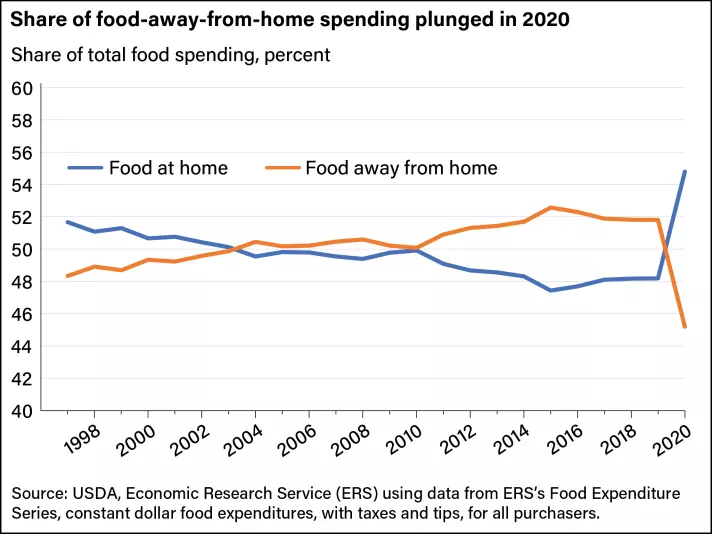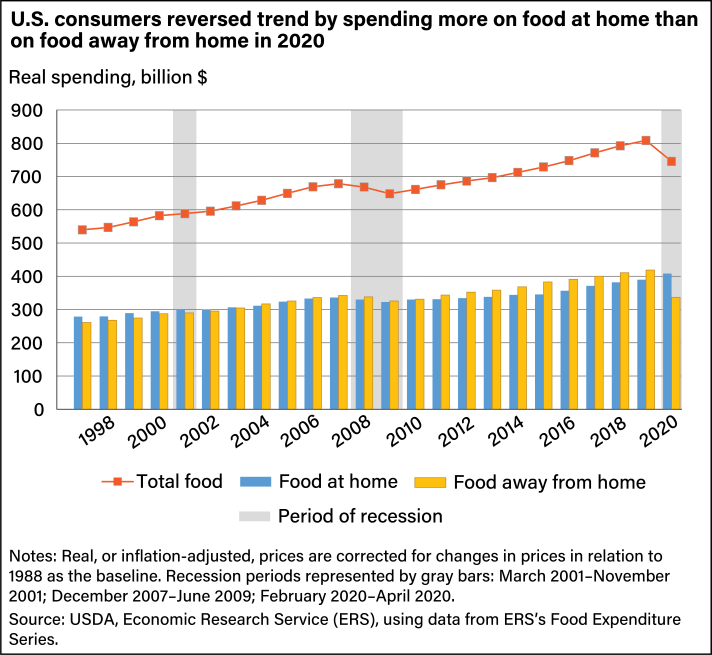Comments
- No comments found

Spending on food is divided into two main categories in the government statistics: “food at home” and “food away from home.” Unsurprisingly, the pandemic caused “food at home” to rise and “food away from home” to fall.
But at least to me, the shift was less dramatic than I might have expected, and “food away from home” remains quite high. Eliana Zeballos and Wilson Sinclair of the US Department of Agriculture discuss the patterns in “Food Spending by U.S. Consumers Fell Almost 8 Percent in 2020” (Amber Waves, October 4, 2021).
Here’s the split between food at home and food away from home over time. The sharp pandemic-related movements in 2020 are obvious. But I remember being surprised when the food away from home share began to exceed the food at home share in 2020.

Here’s the spending in terms of dollars. The drop in total food spending of 8% in 2020 shows that the rise in the dollar value of food at home was smaller than the dollar value of the drop in food away from home.

Of course, the food away from home category is actually a bundle of goods and services: that is, it combines food with shopping, preparation, service and clean-up. A shift to food at home is also a shift to providing many of those complementary services yourself.
For my own family, we became more likely during the worst of the pandemic to prepare meals at home that used more costly ingredients, like cooking the steak or making the cocktails at home, given that we weren’t going out to eat. We ate our share of spaghetti during the pandemic, but we have also added to our repertoire of high-end meals that required unique ingredients, shopping, and prep time. Also, the pandemic strengthened our incentives to identify the local restaurants with especially good take-out options. I suspect that some of those changes will be persistent.
Timothy Taylor is an American economist. He is managing editor of the Journal of Economic Perspectives, a quarterly academic journal produced at Macalester College and published by the American Economic Association. Taylor received his Bachelor of Arts degree from Haverford College and a master's degree in economics from Stanford University. At Stanford, he was winner of the award for excellent teaching in a large class (more than 30 students) given by the Associated Students of Stanford University. At Minnesota, he was named a Distinguished Lecturer by the Department of Economics and voted Teacher of the Year by the master's degree students at the Hubert H. Humphrey Institute of Public Affairs. Taylor has been a guest speaker for groups of teachers of high school economics, visiting diplomats from eastern Europe, talk-radio shows, and community groups. From 1989 to 1997, Professor Taylor wrote an economics opinion column for the San Jose Mercury-News. He has published multiple lectures on economics through The Teaching Company. With Rudolph Penner and Isabel Sawhill, he is co-author of Updating America's Social Contract (2000), whose first chapter provided an early radical centrist perspective, "An Agenda for the Radical Middle". Taylor is also the author of The Instant Economist: Everything You Need to Know About How the Economy Works, published by the Penguin Group in 2012. The fourth edition of Taylor's Principles of Economics textbook was published by Textbook Media in 2017.
Leave your comments
Post comment as a guest